Let’s park the problem
We tour London’s coach bays with LTCOA and CPT to discover the issues with parking in the capital. It’s time for a rethink…
Despite the sloshing rain, it was tourists that flooded Buckingham Gate in London. The iconic British treasure that is Buckingham Palace draws a considerable number of visitors and not a small amount are whisked there by coach. That’s an encouraging sign for all involved in tourism, but coaching in London is, as readers may well know, fraught with problems. One of the major issues is parking and picking-up, setting-down passengers.
To explore these issues, Bus and Coach Buyer braved the rain and toured a selection of the city’s coach bays, joined by two professionals steeped in operating in the capital; CPT’s Andy Warrender and LTCOA’s Peter Bradley, author of London Latest column.
The first stop of the tour was Buckingham Palace Road. On arrival, it was clear what one of the main issues is; a coach from overseas had parked on the side of the road, causing disruption, especially as it was a matter of yards from a traffic-light controlled junction. The honks from vehicles’ horns gave an insight into how frustrating this was for fellow road users. Andy and Peter also remarked how despairing this must be for the residents of the road too.
TfL’s instructions to coach drivers for this area are clear: “Coaches are not permitted to park or wait on Buckingham Gate (east and west bound). On the sections of single and double yellow line, where there are ‘no loading’ or ‘no waiting’ markings, coaches are only permitted to stop and set down or pick up passengers, the coach must then depart immediately. Similar restrictions apply in narrow side streets, including Palace Street.”
Andy said: “There are no marked bays for coaches in the bus stops. In essence, you could drop off passengers anywhere along there.”
It may be understandable for a foreign coach to park incorrectly, perhaps with rules getting lost in translation. But Andy and Peter report there are coaches from the UK that do the same.
There is no parking at Buckingham Gate. Coaches can pick up and drop off passengers but cannot stay. However, due to lack of knowledge of the rules or for other reasons, they sometimes stay. At this notorious tourist hotspot, coaches make regular appearances. August, the time of the tour, is a peak period for tourists into the city and ultimately for this destination. However, Andy was keen to make it clear the problem of heavy congestion and a tangled mess on the roads as coaches set-down and pick-up is an issue prevalent all year round, not just during the summer.
The coach mentioned above was not the only one incorrectly parked, another one soon joined it. It was clear how, with cars and other traffic squeezing passed, collisions and accidents could happen. Andy said: “I’m surprised there’s not a pile of wing mirrors down there.”
Another issue, again demonstrated by coaches from overseas on the day of the tour, was offside loading of passengers. This sees them walk onto the road to get onboard.
The pair did acknowledge the difficult job that coach drivers face in this tourist hot-spot. Peter said: “Because it is raining, there is probably pressure on the driver to get the party as close to the Palace gates as possible. So we have some empathy. The driver is isolated from their base, they have some 50 or 60 customers onboard and they have to cope with all that driving in London throws at them. It’s a huge challenge, no matter how well trained you are. So I can see why people will take chances.”
Andy said: “It’s a pressured environment. Especially when you have 50 or 60 passengers who have paid handsomely.”
Commenting on who carries out these incorrect practices, Andy said: “It does seem to be the foreign coaches that are the worst offenders.”
Regardless of whether it is coaches from overseas or the UK incorrectly parking and generally not adhering to guidelines, the disruption caused casts a negative light on the coach industry as a whole. It damages its image in the public’s eye.
Unfortunately, there is not much the CPT or LTCOA can do to rectify the behaviour of operators from mainland Europe. Peter said: “There is nothing we can do as a trade body. Our members tend not to be the ones who are at fault.”
Andy said: “Undoubtedly one of the biggest issues here is lack of facilities.”
Peter suggested putting a coach drop-off bay the other side of the road. This would mean passengers would not need to cross the road, increasing safety and aiding traffic flow.
Good coach policies are achievable in big cities, Andy notes. He said: “Paris is a good example of coach management. But it is expensive. With the price comes parking and facilities the city provides for tourists. Congestion is less of an issue there, so the passenger experience is far superior.”
Peter agreed: “It’s not got the same challenges as London.”
Andy added: “It is often unfair when London is compared to other European cities. For example, Florence is often compared with London. Coaches are largely barred from the main tourist areas and visitors are dropped on the periphery but the thing is, the geography of that city means there is a lot within walking distance, while London is a lot more spread out.”
Peter highlighted another issue: “London is still growing. There are great amounts of construction work. As for the infrastructure, there is especially a lot underground, which is a problem. For example, there is a Victorian gas pipe that requires some work, but to get at it, the road needs digging up.”
Such construction and maintenance work often results in congestion and occasionally the closure and disruption of coach bays.
Ideal location
After battling our way through the umbrella-toting tourists come to see the Queen’s house, next on the list was Tothill Street, a walk away from Buckingham Palace. Andy and Peter suggested this site is an ideal location for coaches to park after dropping-off at the nearby Buckingham Gate. That is, if they can get a space.
While walking to this site, something noticeable was coaches driving past repetitively. This is quite common, as the driver drops-off passengers and then searches for a coach bay. These spaces are a rarity, so what often happens is the driver ends up circulating the area searching, often until it is time to pick up the passengers again. Unfortunately, this adds to the congestion, not to mention the frustration of the driver, who is already pressured by the experience of driving in London.
The six Tothill Street bays are in a prime location, as not only are they ideal for serving Buckingham Palace, but Westminster Abbey, nearby conference centres and other popular locations for groups. However, no doubt because of this, the bays were full on arrival. Peter said: “This isn’t a bad road to have coach bays in, but the challenge here is you are lucky to find a bay that’s free.”
Andy quipped: “Today a coach driver finds a bay here; tomorrow they win the lottery!”
There are more bays further afield, such as in Millbank by the Tate Britain. “But they are in short supply,” said Andy.
Moving on from Tothill Street, past Westminster Abbey, the pair mentioned there are no real figures on the number of coach passengers coming into London. This makes it hard to leverage support from local authorities, as there is no quantifiable proof of the positive impact the coach brings to the city; no figure of tourists lost if coaches are longer able to serve the capital.
The tour continued on foot, taking us past the Houses of Parliament, where sadly Big Ben’s face was hidden by scaffolding as it is given a facelift. The next stop was Embankment, a picturesque location by the Thames, complete with views of the London Eye and, just around the corner, the Houses of Parliament. It is also next to piers for the Thames river boats.
The Embankment coach bays were well used. Andy noted it is a popular area for tourist coaches to come, being close to the city’s attractions. However, a rarity showed itself: an empty bay!
It used to be popular for commuter coaches too. This is not so much the case any more, as Clarkes and The Kings Ferry have relocated their commuter coaches in recent years.
This site had 28 bays removed during the work to create the Cycle Superhighway. Peter said: “TfL worked hard to find alternative locations. But we are aware 11 still need to be found.”
“The problem we have got,” said Peter. “Is that you may ask: where are the cyclists?” He was right; on visiting the Embankment at just before midday, there was a dearth of pushbikers. Peter continued: “In peak times, there is a reasonable number of cyclists. But now, nothing. The thing that I am always keen to see is the use the space for different things. So at peaks times of day, it could be a cycleway; but in times of low demand, it could be used for coach spaces.”
“The cycleway is wide enough to get a coach into,” Andy wryly hinted.
Peter added: “I just think local authorities could be more creative with how they use kerb spaces. With such limited kerb space, I would love to see more thought given to it.”
Coach bays on the Embankment are currently being affected by the Thames Tideway works. This project is seeing a ‘Super Sewer’ being built beneath the Thames. That might be welcome news for residents, but it does mean some bays at the Embankment are closed. Andy and Peter were not entirely confident the authorities will reinstate the bays.
Taking to a coffee shop near Charing Cross station for a spot of lunch, it was mentioned the coach parking map created by TfL is no longer available as a hard copy, but is instead only published online (https://bit.ly/1rdGsKT). Peter said it is regularly updated by TfL and hopes for this to continue.
Eye for coaching
A trip on the Tube took us to Waterloo and following a short walk we arrived at the London Eye. More specifically, the coach bays at the Eye on Belvedere Road. There are normally six bays here, but the recurring theme of construction work reduced the number of bays available. Despite this, there are very few complaints or negative comments that are heard about this particular facility, according to Andy. “No news is good news,” he said.
The site is run by Merlin Entertainments Group, the attractions company, as is the Eye itself. Coach spaces must be booked with the owner ahead of time (at [email protected]).
Another issue apparent on the visit to the Eye was vans and other vehicles parked in coach bays. It does happen occasionally. Andy said: “It could be quite severe and it’s not something which affects just the Eye bays.”
The bays at the Eye are free, but coaches are only able to wait there for 40 minutes (20 minutes set-down and 20 minutes pick-up). Picking-up passengers is always more difficult than dropping-off, Andy noted. He said: “There are times you don’t know when the party will be back.”
Unlike the others visited, the Eye bays have a Marshall. The one on duty at the time of the visit was Dorothy Smailles. Her job there is to direct coaches and tend to the drivers in July and August. Dorothy is an old hand at her job, having worked there since it was opened.
She said of the drivers that arrive at the bays: “It usually works very well here, the drivers are very good. They usually do as they’re told. Sometimes it can be difficult if they are foreign and they don’t understand English. But it’s no problem really. The youngsters that do this job as well, they sometimes don’t know how to handle the drivers. But I think that’s a life experience thing; they don’t have the life experience I do.”
After the Eye, there was a short walk to a nearby bus station for a ride to the next stop. A matter of yards from the Eye coach bays, there was what Peter noted as a spare bus stop on Chicheley Street. He said: “That could make a great extra bay.”
Catching the 521 bus route, which Peter said is thought to be the most frequent route in the country at its peak times, another issue surrounding coach parking emerged. As the bus made its way through the Kingsway Underpass (a former tram tunnel) traffic ground to a halt. Eventually emerging the other side of the tunnel, the reason for the delay became clear. A coach was parked seemingly incorrectly, creating a problem for oncoming traffic, slowing it down. It seemed like there was no activity taking place, no loading or dropping-off of passengers.
Alighting the bus at Kingsway saw us arrive in a theatre-rich part of the city. Andy and Peter explained this is where a lot of coaches drop-off and pick-up theatre goers. Trees offer a green, tranquil respite from the grey urban expanse and gaily coloured signs of the road here. Despite this, they also prove problematic for buses. Coaches are permitted to stop in the bus lane here, but that does not cause much disruption to the buses, as the overhanging trees can be dangerous for double-deckers to drive beneath. Signs are placed along the route reminding drivers of larger vehicles of the danger of colliding with the branches.
Kingsway was the largest coach bay visited during the day, parking up to 16 coaches. Parked coaches here tend to give each other plenty of space, considering the amount of street furniture that is relatively close to the road. This gives them more room to manoeuvre out of the bay. “But we have no complaints about coaches taking up too much space,” said Andy.
Kingsway is a site CPT and LTCOA really do not want to lose. Both sides of the road can be used, where parking is permitted for up to four hours between 10am and 4pm and 7pm until midnight. LTCOA and CPT have lobbied for removal of the peak hour restriction, which is a major issue for coaches, and as buses do not use the bus lane due to the trees anyway, it is a wasted opportunity. Andy said: “It’s overnight space begging to be used.”
Pay or lose out
An issue not just at the Kingsway bays, but elsewhere, is drivers not paying for parking. There has been some evidence of that. Peter said: “A message we are trying to get across is for drivers to pay what they owe.”
Andy said: “I don’t think there is the conversation being had between some operators and drivers about paying for parking.”
Peter added: “The coach driver is far more an ambassador than a bus driver, dealing with passengers. With that comes responsibility. Operators should make sure drivers pay or ultimately, we may lose those bays. Drivers may think they are doing their boss a favour by not paying, but ultimately they are contributing to the demise of coach bays.”
According to Andy: “There are 38 different demands on kerb-side space in London. If coaches are not paying, then those demands can change and coaches might lose their spaces.”
Coach parking spaces disappearing is a reality and has happened recently, with the closure of coach parking at London Zoo. “This was a major blow,” said Andy. “In general, there is a lack of understanding for the coach industry and a lack of common sense from boroughs. There is a lack of will to solve the problems. But in fairness though, Westminster have engaged and the City is very good.”
Also commenting on working with local authorities, Peter said: “We find that there are a few individuals that are very good. But once they have left or moved on, nobody seems to step up.”
“The nature of councils is there is a high turnover rate of staff, so it is difficult to maintain sustained engagement,” Andy added.
- A useful resource for coach parking in London is on TfL’s website: https://bit.ly/305XP1N
- The Coach Parking Map is available here: https://bit.ly/1rdGsKT
- Information and advice can also be found at the websites of CPT (www.cpt-uk.org) and (www.ltcoa.co.uk)

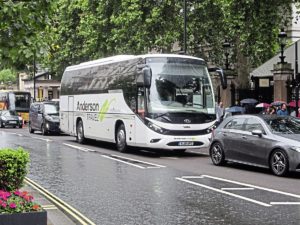
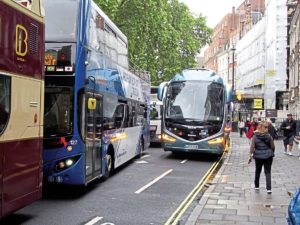
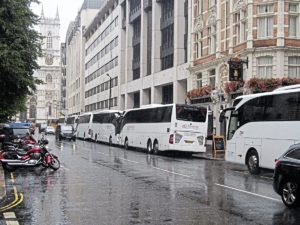
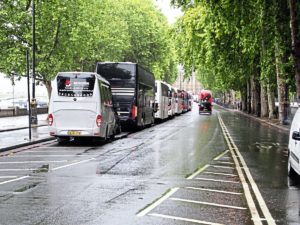
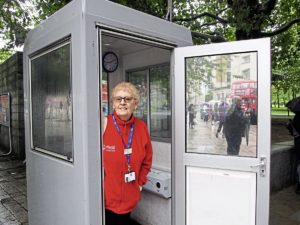
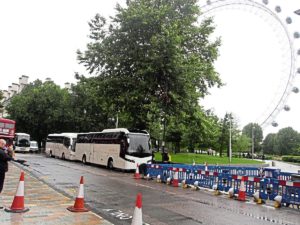
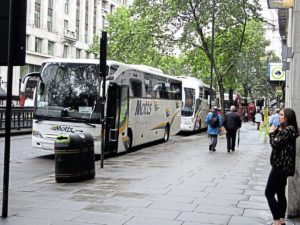
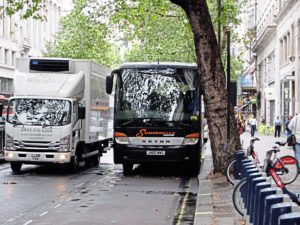
It’s a relatively simple cure.
Extend Bayswater Road coach park, to use exclusively for tour coaches. A daily parking charge, and a cafe for drivers. Open top buses have a terminal in there, to pick up groups for the on/off tours, or the companies increase their daily tarrifs and pay for a daily permit to be inside the tourist areas. It’s us that are the cause of so many problems, getting in the way etc..BUT not our fault.
Hello, travelling into and out of London has gotten to be a nightmare, but trying to drive around whilst also trying not to go over your driving hours has become an extremely stressful job, we have in excess of 22000. Hackney cabs, private hire cabs, local service buses that seem to have a frequency of 1 a minute, now we also have 4 open top tourist buses operating, many more motor cycles and pedal cycles on the roads, so I don’t believe Coaches are the main problem, the local council’s build on coach parks and don’t give us an alternative, they go on about congestion and emissions, we also have clients needs and hours to consider, so for us Coach Drivers it’s a complete headache from leaving the motorway to getting back onto the motorway, and the situation is going to get much much worse. I think to the point where we see bookings for London suffer.
I read with interest your comments on London and visiting coaches. I actually visited the Capital on Sunday 28th July arriving at the Eye at 2.40pm, no marshal, coaches parked & left ,Premium Tours ERM’s parked on the pavement ! and cars parked illegally on the opposite side of the road. Coupled with this the ongoing road works it was mayhem. I couldn’t reach the kerb and had to double park for customers to exit.
Having traveled from Newcastle on Tyne I was required another 45min break soon. But finding a spot was another nightmare. On picking up at 5pm the scene was just as bad, but at least those coaches which had left now had a driver. The ERM fleet were finishing so decided to move but I had the job stopped double parked again to pick my customers up. The ERM drivers were not happy but I commented that I was doing my job and being parked up causing an obstruction.
Buckingham Palace was just as bad on Monday 29th July at 9.40am. Our company National Holidays don’t have a courier/guide so I had to book my customers in, next a PC is ready to haul me out of the que because my vehicle was left unattended even though customers were still on board. I did suggest once for additional parking but obviously this fell on deaf ears.
The up shot of this manic 2 days you can keep London it’s not worth the hassle.